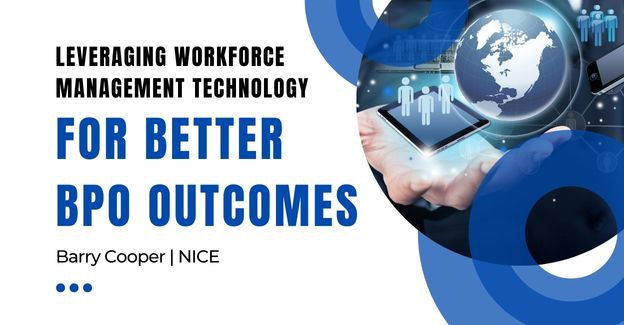BPO contact centers need to evolve to manage consumer interactions on digital channels says Barry Cooper, President at NICE Workforce & Customer Experience Division. He details how an increasing number of BPOs are leveraging digital workforce management technologies to meet the needs of an increasingly digital contact center.
Consumers’ expectations are evolving more rapidly than ever before, making it imperative for business process outsourcing (BPO) call centers to manage an increasing number of channels and agents with a wide variety of skill sets. Adoption of digital channels surged during the pandemic, with nearly all consumers becoming digitally savvy.
And there’s no going back: Consumers expect to continue using digitally enabled services that go beyond voice, emails and chat to also include the internet, apps and more. As they do, it’s placing ongoing pressure on BPO contact centers to manage interactions on digital channels, which often require agents to handle multiple contacts simultaneously or prioritize one type of an interaction over another.
In this new, increasingly complex environment, a growing number of BPOs are leveraging digital workforce management technologies to meet the needs of their agents and customers alike. Workforce management technologies create efficiencies by equipping agents and creating agility in schedules to meet service-level agreements and target KPIs while providing superior customer service.
Here’s how you can leverage advances in workforce management technology to navigate the continuously changing contact center environment – and meet escalating agent and customer expectations.
Plan for the Future More Accurately
It’s safe to say that most BPO contact centers recognize the importance of same-day decisions on long-term performance, but many fail to tap into the full ROI of long-term planning. Modern workforce management solutions help you get more out of workforce planning by leveraging artificial intelligence (AI) to consider channels, business rules, and the needs and skills of your employees to determine how many people you need to handle the expected workload. This allows you to predict how anticipated or potential staffing scenarios will impact your ability to meet service-level targets and performance goals.
Look for a solution with advanced long-term planning capabilities, such as what-if analyses and reverse problem-solving between staffing requirements and performance metrics. You’ll want to ensure that the workforce management solution you choose is set up for digital channel management, with capabilities like detailed shrinkage modeling, digital concurrency factors and multi-skill efficiency factors.
Forecast More Efficiently and Effectively
A good forecast gives your business the tools it needs to understand future workforce needs, so you can manage your workforce more effectively and eliminate over-staffing. Workforce management solutions on the market today leverage AI to find unseen patterns in the historical data used to generate volume and work time forecasts. They automatically evaluate dozens of algorithms and leverage historical data patterns, seasonality and cyclicality to make forecasting more accurate. Perhaps most importantly given the rapid rate of change today, they adapt to changing data patterns and incorporate digital attributes.
Enable Real-World Simulation for Scheduling
Ensuring that the right agents – with the right knowledge, background and skillset – are on hand at the right time to respond to a specific customer service question or situation can be a significant challenge. After all, an agent who excels on the phone may have trouble managing three or four chats simultaneously.
Modern workforce management solutions move beyond traditional mathematical formulas, which use historical data to optimize schedule creation. Instead, they leverage machine learning to simulate real-world prioritization, routing and skill assignments to determine work allocation expectations, deferrable work propagation and multi-site/multi-skill efficiencies.
Look for a solution that uses forecasting algorithms to create the right schedule based on available agents’ skill sets, diversifying the number of agents with particular skills across all areas at any given time while incorporating digital attributes and a multi-session efficiency factor.
While business goals are a primary concern, don’t overlook the importance of giving flexibility to agents. In today’s frenzied labor market, which has made it more challenging than ever for contact centers with consistently high attrition to fill open positions, you need to give agents control over their work-life balance in order to attract and retain employees. Consider a workforce solution that offers a variety of flexible options, including the ability to incorporate employee preferences in the scheduling process.
Manage Intraday Change
Your workforce managers’ jobs aren’t done when the schedule is set – change is inevitable and you must respond accordingly. Intraday management capabilities provide comprehensive, real-time schedule and activity adherence, regardless of where your agents are working. Intraday analytics provide net staffing calculations by queue and take agent skillsets as well as success rates of all self-service bots and IVR into account, helping you automatically reforecast and re-simulate demand throughout the day.
Use Automation to Improve Net Staffing, Intraday and Near-Term
Workforce management solutions allow you to optimize staffing through automated self-service for employees and proactive schedule adjustments. Intraday automation leverages robust rules to help you streamline workflows and reduce complexity, increase efficiency and simplify multi-step decision-making.
For example, automation that empowers employees to make pre-approved changes on the go allows them to improve their work-life balance (which increases employee engagement and, ultimately, customer satisfaction levels) while proactively improving net staffing.
Look for a WFM Solution Built With BPO Needs in Mind
Most BPO providers need to be able to not only add the in-house forecast or requirements to their workforce management solution but also extract the schedule information to be sent back to the in-house client as a supply. This two-way process needs to be as simple and as automated as possible to reduce manual effort and human error.
- Importing client requirements: BPOs need to import forecast and AHT demand into their workforce management solution, and intelligent automation allows you to do so with reduced time and effort. Look for a solution that allows you to import contact forecast data into your workforce management for one or more contact types as well as import interval values or daily values (which are then are allocated to periods within the date based on the existing forecast distribution).
- Exporting BPO performance: Most BPO contracts stipulate that the BPO provider send its performance or resource “supply” back to the in-house client. While this can be time-consuming, it’s an important part of the planning process. Look for a workforce management solution that allows you to automate how BPO supply is extracted and easily share actual performance data related to contacts, AHT, abandons and service level or the estimated staff value, which reflects the BPO’s productive hours, throughout the day.
BPO contact centers are no longer merely a “black box” source of cost-effective labor; rather, they are increasingly serving as true partners with the clients they serve. As they do, increased transparency and sharing of technologies—including digital workforce management solutions—have become the norm. By leveraging digital tools built to plan, forecast, schedule, manage and automate workforce management, you can not only navigate the constantly changing contact center environment but also position your organization for continued growth.







